HKJ
Flashaholic
[size=+3]Charger NiteCore UM20[/size]
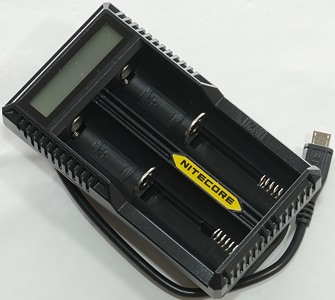
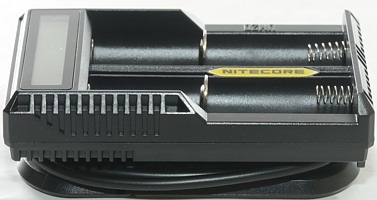
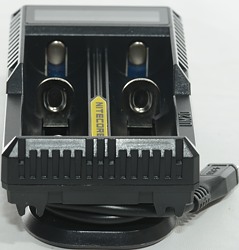
Nitecore has been known for the i2 and i4 chargers for a long time, but lately they have expanded their range with D2, D4, U10 and this UM20. This charger is a simple two channel usb powered charger, it does also have a usb output, but it is not a power bank.



The charger is sold in a blister pack, making it very easy to see it.
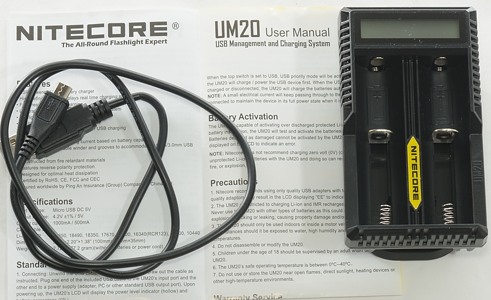
There is not much contents in the package: The charger, a usb cable and a instruction sheet.
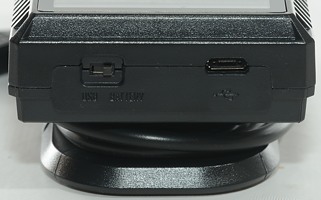
On the back of the charger is the micro usb power input and a switch to select priority, i.e. where does the power go: to usb output or to charging batteries.
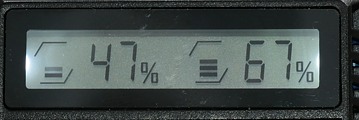
The charger has a display with background light. While charging the bars are animated. With my 3100mAh batteries the percent display starts at about 40%. The background light is not very uniform across the display.

When something is connected to the usb output a usb symbol will be shown between the two channels.
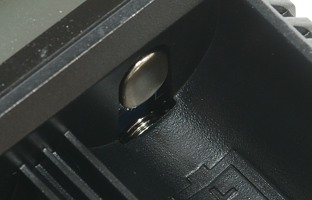
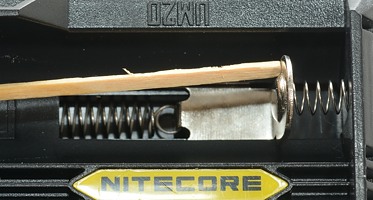
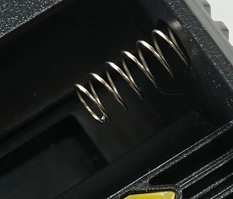
The slots uses the usual construction and works well. They can handle batteries from 30mm to 69.3 mm long.
That excludes a few of the longest batteries.
The rear spring is used to select between 0.5A and 1A charge current.
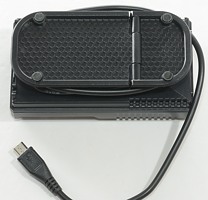
The bottom of the charger with the usb cable wound around it.
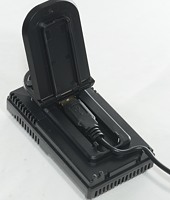

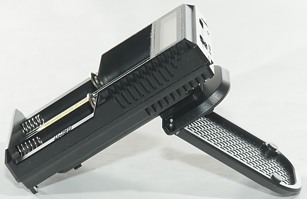
The output usb connector is hidden beneath the bottom of the charger.

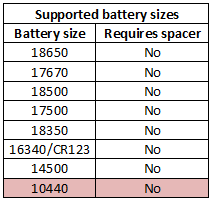
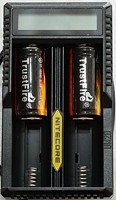
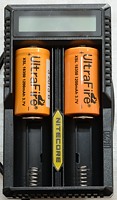
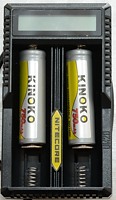
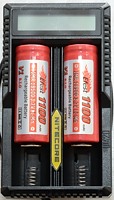
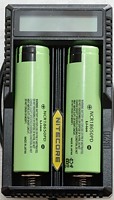
The specifications also list 10440, but the charge current is to high for them, except for IMR types.
The charger can handle 69.3 mm long batteries, inclusive flat top cells.
[size=+2]Measurements[/size]
[size=+1]Charging[/size]
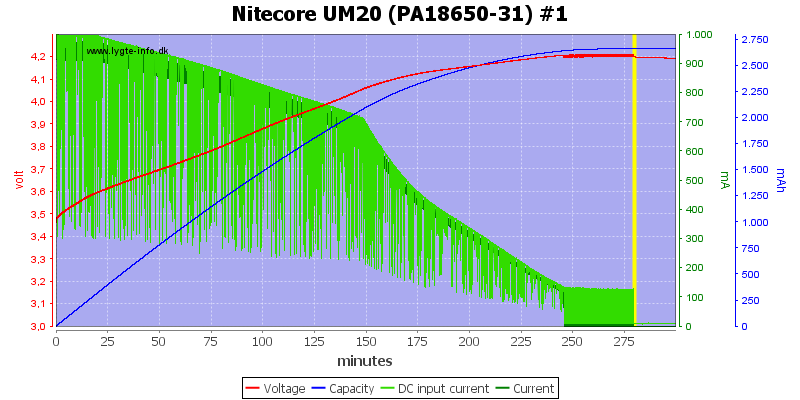
A 18650 battery is charged with 1A, at least initially, but when the battery voltage increases the charger will reduce the current. When the battery is nearly full the charger will oscillate a bit, before terminating the charge. The charger still qualifies as a CC/CV charger, but is on the slow side.
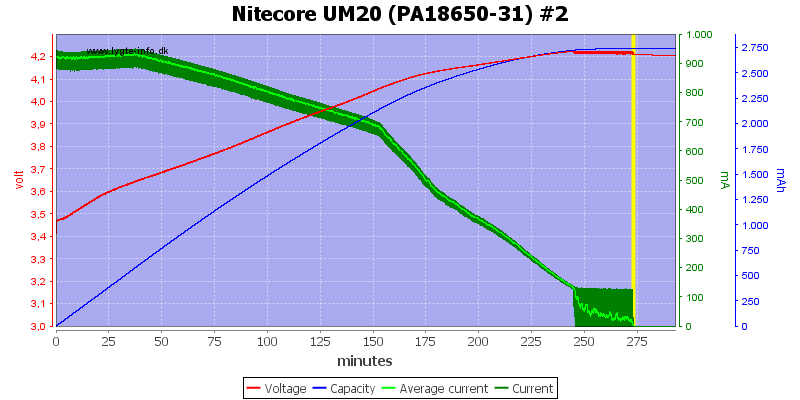
With the average current included it looks like the charger terminates at about 30mA.
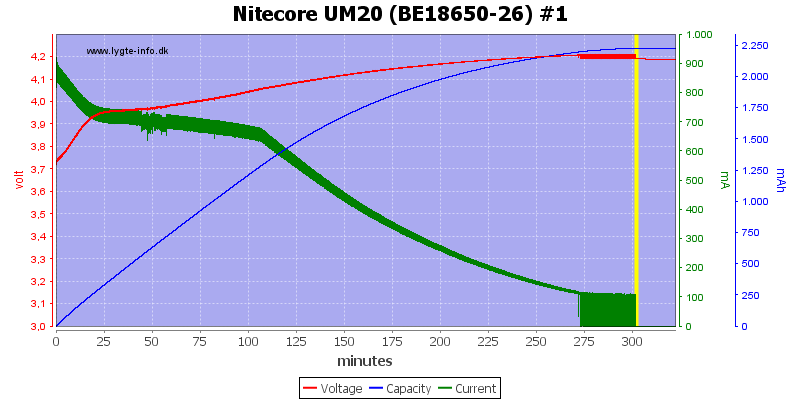
This battery is showing its age, but the charger handles it fine.
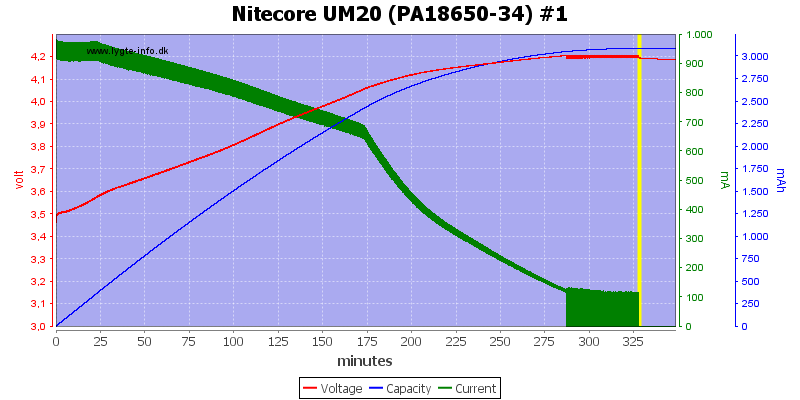
The 3400mAh is a bit slower to charge.
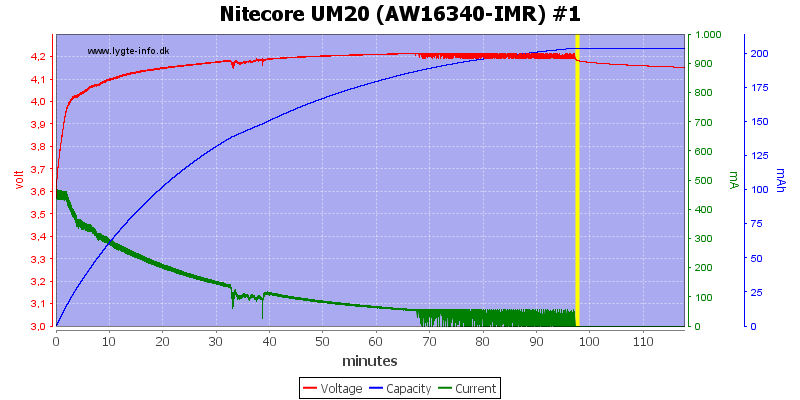
My old 16340 cell is also handled without any problems.
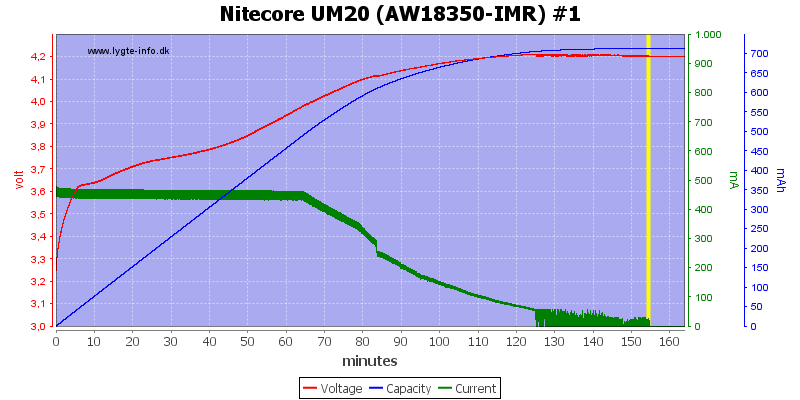
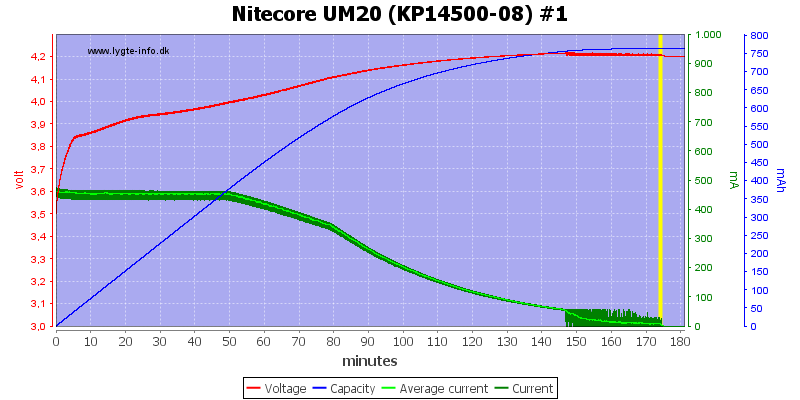
No problem with the two smaller batteries, they are charged with 0.5A because the slider does not touch the rear spring.
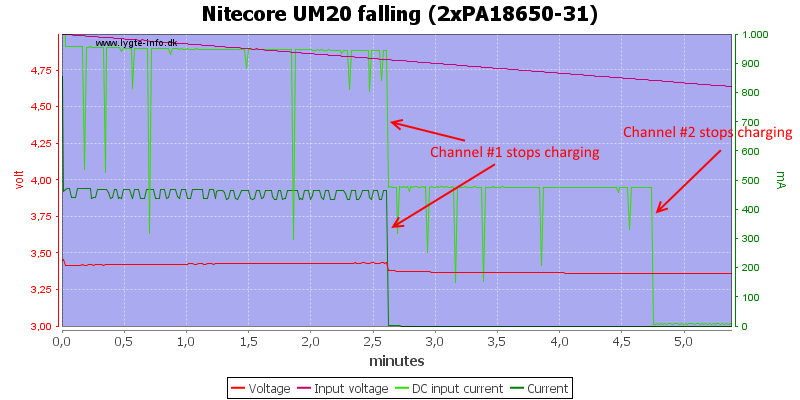
Using a falling voltage as supply it can be seen that the charger stops first channel at about 4.8 volt and second channel at about 4.7 volt.
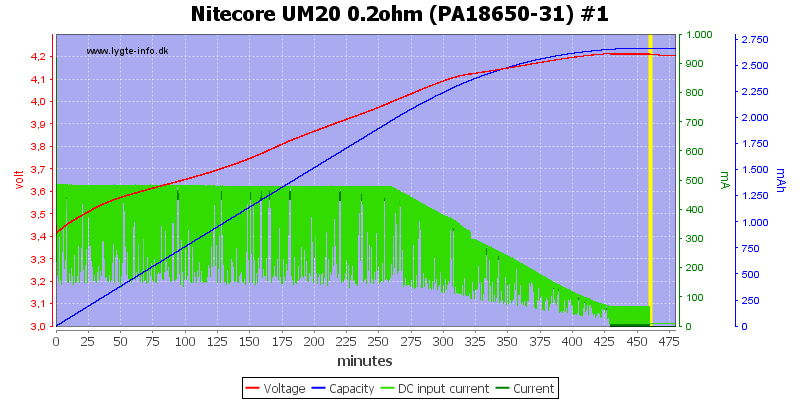
I tried using the charger with 1ohm and 0.5ohm in series with my 5 volt power supply, that did not work, it shows "EE".
With 0.2ohm I could do a charge and it looks fairly normal, except the charger is only charging with 0.5A.
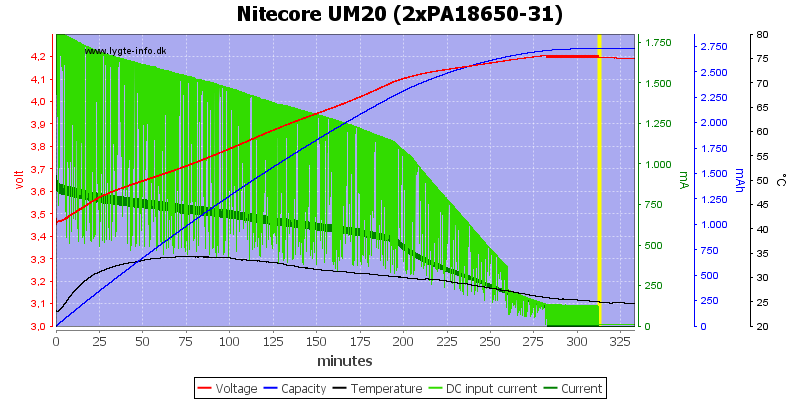
With two batteries the initial usb current is about 2A, this requires a good usb supply.
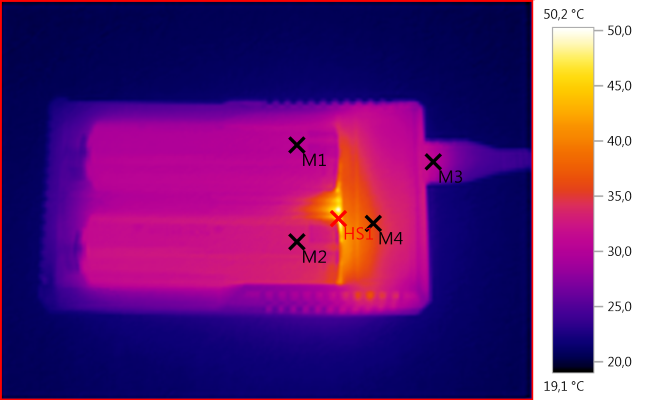
M1: 30,6°C, M2: 33,2°C, M3: 30,6°C, M4: 36,1°C, HS1: 50,2
The charger keeps the batteries cool during charge.
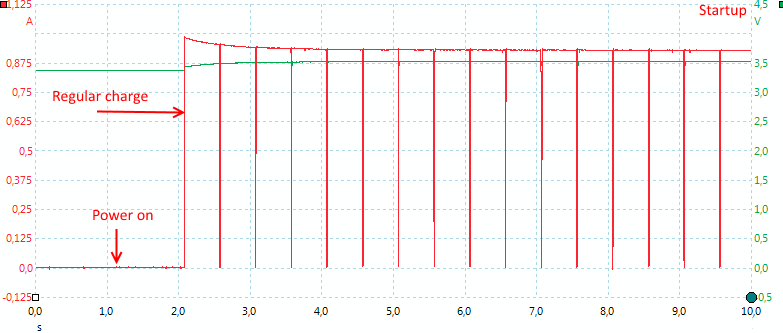
The charger is very fast to start, only 1 second.
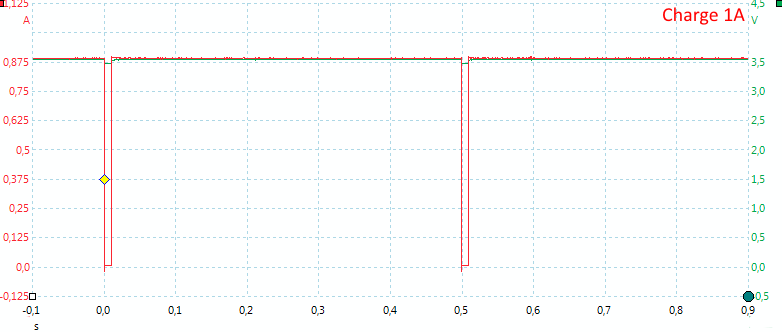
It pauses the charge to measure the voltage, i.e. it uses a simulated CC/CV charge.
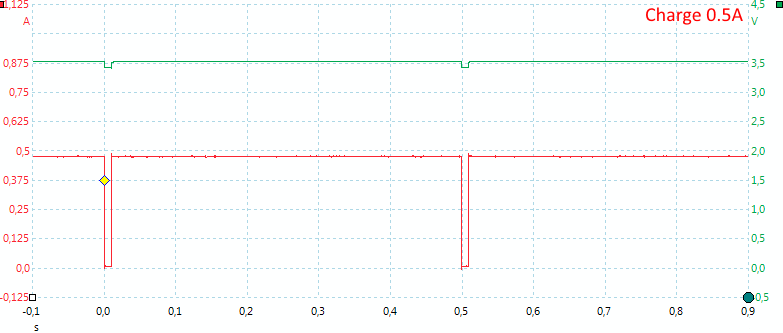
The 0.5A charge is done by reducing current, there is no pwm.
[size=+1]USB output[/size]
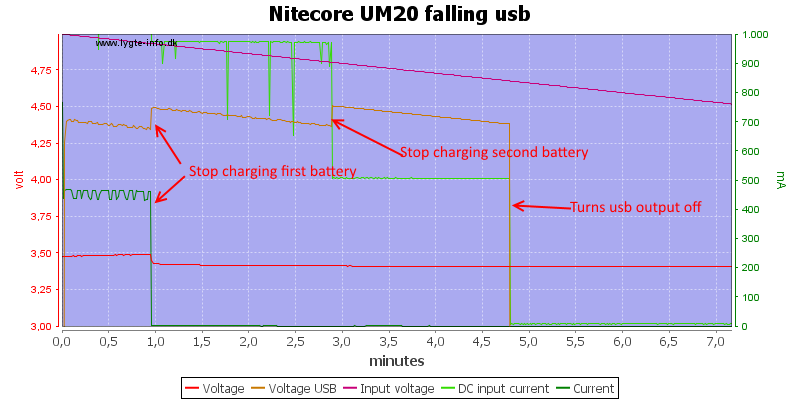
Doing the falling voltage with 0.5A load connected to usb output and switch in "usb" position.
Here the charging is stopped first (The animated bars stop animating on the display). When the voltage is to low the usb output is also turned off.
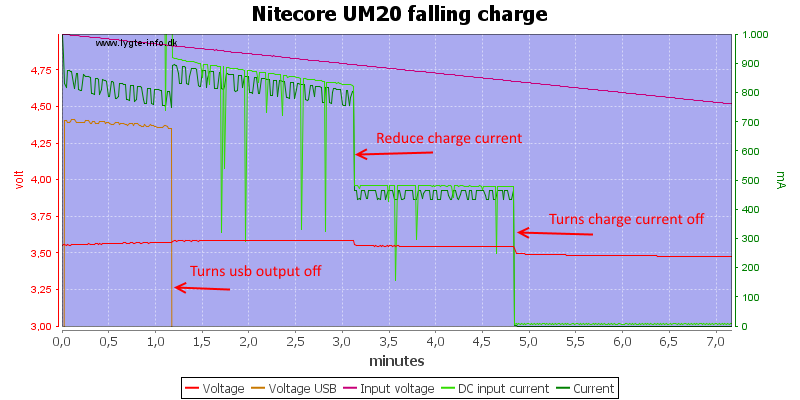
Same as above, but this time with switch in "Battery" position.
The first thing that is turned off is the usb output, then it reduces charge current and when the voltage is to low stops charging completely.
[size=+2]Conclusion[/size]
This is a dual channel usb charger with automatic current select and a simulated CC/CV charge profile. It has a usb pass through connector, making it possible to charge two batteries and a phone without moving wires around. With the switch it is possible to select what get charged first: batteries or phone.
To handle two batteries a fairly powerful usb power supply/charger is needed.
The possibility to charge two 18650 with 1A on usb is rather impressive, in praxis the charger cannot do it, but will be slower. The lower charge current is useful for smaller batteries.
I know a couple of times where I would have liked a charger with pass through function, but I would usual also like a power bank function at the same time.
It is a good charger, but I wonder how useful the pass through function is.
[size=+2]Notes[/size]
The charger was supplied by a Nitecore for review.
Nitecore has made a video explaning the function of the charger/usb output.
Here is an explanation on how I did the above charge curves: How do I test a charger



Nitecore has been known for the i2 and i4 chargers for a long time, but lately they have expanded their range with D2, D4, U10 and this UM20. This charger is a simple two channel usb powered charger, it does also have a usb output, but it is not a power bank.



The charger is sold in a blister pack, making it very easy to see it.

There is not much contents in the package: The charger, a usb cable and a instruction sheet.

On the back of the charger is the micro usb power input and a switch to select priority, i.e. where does the power go: to usb output or to charging batteries.

The charger has a display with background light. While charging the bars are animated. With my 3100mAh batteries the percent display starts at about 40%. The background light is not very uniform across the display.

When something is connected to the usb output a usb symbol will be shown between the two channels.



The slots uses the usual construction and works well. They can handle batteries from 30mm to 69.3 mm long.
That excludes a few of the longest batteries.
The rear spring is used to select between 0.5A and 1A charge current.

The bottom of the charger with the usb cable wound around it.



The output usb connector is hidden beneath the bottom of the charger.







The specifications also list 10440, but the charge current is to high for them, except for IMR types.
The charger can handle 69.3 mm long batteries, inclusive flat top cells.
[size=+2]Measurements[/size]
- Below 2 volt on the batteries the charger reports EE and will only charge with 1mA.
- Between 2.0 and 2.5 volt the charger will charge with about 130mA
- Above 2.5 volt regular charge current will be applied.
- Charger will not restart if voltage drops, but the percent scale will be updated.
- Charge will restart charging after power loss, or battery insertion.
- When not connected to power it will drain about 0.65mA from a battery
- When charging is finished the charger will charge with 0.2mA to the battery.
- When usb voltage is low the charger will only charge one battery at a time.
- Percent scale: 0%=2.9V, 10%=3V, 30%=3.3V, 50%=3.6V, 70%=3.85V, 90%=4.1V
[size=+1]Charging[/size]

A 18650 battery is charged with 1A, at least initially, but when the battery voltage increases the charger will reduce the current. When the battery is nearly full the charger will oscillate a bit, before terminating the charge. The charger still qualifies as a CC/CV charger, but is on the slow side.

With the average current included it looks like the charger terminates at about 30mA.

This battery is showing its age, but the charger handles it fine.

The 3400mAh is a bit slower to charge.

My old 16340 cell is also handled without any problems.


No problem with the two smaller batteries, they are charged with 0.5A because the slider does not touch the rear spring.

Using a falling voltage as supply it can be seen that the charger stops first channel at about 4.8 volt and second channel at about 4.7 volt.

I tried using the charger with 1ohm and 0.5ohm in series with my 5 volt power supply, that did not work, it shows "EE".
With 0.2ohm I could do a charge and it looks fairly normal, except the charger is only charging with 0.5A.

With two batteries the initial usb current is about 2A, this requires a good usb supply.

M1: 30,6°C, M2: 33,2°C, M3: 30,6°C, M4: 36,1°C, HS1: 50,2
The charger keeps the batteries cool during charge.

The charger is very fast to start, only 1 second.

It pauses the charge to measure the voltage, i.e. it uses a simulated CC/CV charge.

The 0.5A charge is done by reducing current, there is no pwm.
[size=+1]USB output[/size]
- Usb output is not a power bank, but a pass through connection
- When usb output is used the switch is used to decide between stop charging batteries or turn usb output off when voltage is low.
- The usb to usb resistance in the charger (including my fairly short test cables) is about 0.5 ohm.
- The data pins in the usb are connected, but does not give a stable data connection. I had frequent disconnect/connect events when testing with a memory stick.

Doing the falling voltage with 0.5A load connected to usb output and switch in "usb" position.
Here the charging is stopped first (The animated bars stop animating on the display). When the voltage is to low the usb output is also turned off.

Same as above, but this time with switch in "Battery" position.
The first thing that is turned off is the usb output, then it reduces charge current and when the voltage is to low stops charging completely.
[size=+2]Conclusion[/size]
This is a dual channel usb charger with automatic current select and a simulated CC/CV charge profile. It has a usb pass through connector, making it possible to charge two batteries and a phone without moving wires around. With the switch it is possible to select what get charged first: batteries or phone.
To handle two batteries a fairly powerful usb power supply/charger is needed.
The possibility to charge two 18650 with 1A on usb is rather impressive, in praxis the charger cannot do it, but will be slower. The lower charge current is useful for smaller batteries.
I know a couple of times where I would have liked a charger with pass through function, but I would usual also like a power bank function at the same time.
It is a good charger, but I wonder how useful the pass through function is.
[size=+2]Notes[/size]
The charger was supplied by a Nitecore for review.
Nitecore has made a video explaning the function of the charger/usb output.
Here is an explanation on how I did the above charge curves: How do I test a charger

